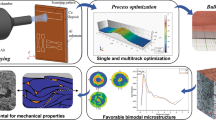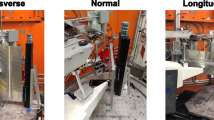Abstract
The influence of welding angle on weld morphologies and porosity characteristics was studied in laser-arc hybrid welding of AA2219 aluminum (Al) alloy. The upward sloping and vertical weld (USVW) was performed better than the downward sloping and vertical weld (DSVW). The high-speed camera was used to observe the welding process. It is found that the welding process becomes stable when the transitional position of the droplet was 2 mm away from the keyhole. By analyzing the force act on keyhole and characteristics of the pool, it is found that the weld morphologies and porosity characteristics were associated with gravity-laser angle (β), which affects the keyhole stability and characteristics of the pool. The results showed that the flow velocity was accelerated when the β increased, which was a benefit for decreasing porosity. This is because the gravity in the direction of the welding accelerates the pool flow. Due to the increasing of the β, the static pressure and the vapor pressure in the keyhole were increased, which improved the stability of the keyhole and decreased the porosity.















Similar content being viewed by others
References
Bagger C, Olson FO (2005) Review of laser hybrid welding. Journal of Laser Applications 17(2):1–14
Ribic B, Palmer TA, DebRoy T (2009) Problems and issues in laser-arc hybrid welding. Int Mater Rev 54(4):223–244
Shi SG, Hilton P, Mulligan S, Verhaeghe G (2004, 2004) Hybrid Nd: YAG laser-MAG welding of thick section steel with adaptive control. Proc ICALEO:25–32
Yan J, Zeng XY, Gao M, Lai J, Lin TX (2009) Effect of welding wires on microstructure and mechanical properties of 2A12 aluminum alloy in CO2 laser-MIG hybrid welding. Appl Surf Sci 255(16):7307–7313
Ueyama T, Tong H, Yazawa I, Hirami M, Kihara T, Nakata K, Ushio M (2004) Aluminum alloy sheet welding by the laser arc pulsed MIG hybrid process. Weld Int 18(5):345–350
Zhang C, Gao M, Wang DZ, Yin J, Zeng XY (2017) Relationship between pool characteristic and weld porosity in laser arc hybrid welding of AA6082 aluminum alloy. J Mater Process Technol 240:217–222
Bunaziv I, Akselsen OM, Salminen A, Unt A (2016) Fiber laser-MIG hybrid welding of 5 mm 5083 aluminum alloy. J Mater Process Technol 233:107–114
Travis D, Dearden G, Watkins KG, Reutzel EW (2004, 2004) Sensing for monitoring of the laser-GMAW hybrid welding process. Proceedings of ICALEO:35–40
Fellman A, Jernstrom P, Kujanpaa V (2003, 2003) CO2-GMA hybrid welding of carbon steel-the effect of shielding gas composition. Proceedings of ICALEO:56–65
Huntington CA, Engar TW (1983) Laser welding of aluminum and aluminum alloys. Weld J 4:105–107
Nation Y, Mizutani M, Katayama SJ (2003, 2003) Observation of keyhole behavior and melt flows during laser-arc hybrid welding. Proc ICALEO:41–47
Nation Y, Mizutani M, Katayama SJ (2006) Effect of oxygen in ambient atmosphere on penetration characteristics in single yttrium-aluminum-garnet laser and hybrid welding. J Laser Appl 18(1):21–27
Nation Y, Mizutani M, Katayama SJ (2004, 2004) Effect of ambient atmosphere on penetration geometry in laser and hybrid welding. Proc ICALEO:41–49
Zhou J, Tsai HL (2008) Modeling of transport phenomena in hybrid laser-MIG keyhole welding. Int J Heat Mass Transf 51(17):4353–4366
Gao Z, Wu Y, Huang J (2009) Analysis of weld pool dynamic during stationary laser–MIG hybrid welding. Int J Adv Manuf Technol 44(9–10):870–879
Hu B, Ouden GD (2005) Laser induced stabilisation of the welding arc. Sci Technol Weld Join 10(1):76–81
Katayama S, Uchiumi S, Mizutani M, Wang J (2007) Penetration and porosity prevention mechanism in YAG laser-MIG hybrid welding. Weld Int 21(1):25–31
Katayama S, Kawahito Y, Mizutani M (2010) Elucidation of laser welding phenomena and factors affecting weld penetration and welding defects. Phys Procedia 5:9–17
Ascari A, Fortunato A, Orazi L, Campana G (2012) The influence of process parameters on porosity formation in hybrid LASER-GMA welding of AA6082 aluminum alloy. Opt Laser Technol 44(5):1485–1490
He WP, Shen XF (2016) Effects of welding positions on welding quality in CO2 laser welding of 5A90 aluminum-lithium alloy. High Power Laser Part Beams 28(8):089001
Schinzel CM, Hohenberger B, Dausinger F, Huegel H (2000) Laser welding of aluminum-extended processing potential by different wire positions. Proc SPIE 3888:380–391
Tomsic M, Barhorst S (1984) Keyhole plasma arc welding of aluminum with variable polarity power. Weld J 63(2):25
Nunes AC, Bayless OE, Jones CS, Munafo AP, Wilson WA (1983) The variable polarity plasma arc welding process: Its application to the Space Shuttle external tank. NASA Technical Reports Server TM-82532.
Wang J, Wang GZ, Wang CM (2015) Mechanisms of the porosity formation during the fiber laser lap welding of aluminium alloy. Metalurgija 54(4):683–686
Kawahito Y, Wang HZ (2018) In-situ observation of gap filling in laser butt weld. Scr Mater 154:73–77
Steen WM (1980) Arc augmented laser processing of materials. J Appl Phys 51(11):5636–5641
Diebold TP, Albright CE (1984) Laser-GTA welding of aluminum alloy 5052. Weld J 63(6):18–24
Avilov VV, Decker I, Pursch H, Wendelstorf J (1994) Study of a laser-enhanced welding arc using advanced split anode technique. Weld J 11(2):112–123
Forsman T, Powell J, Magnusson C (2001) Process instability in laser welding of aluminum alloys at the boundary of complete penetration. J Laser Appl 13:193–198
Arata Y (1987) Challenge of laser advanced materials processing. Proceedings of LAMP, Osaka, pp 3–11
Dowden J, Kapadia P, Clucas A, Ducharme R, Steen WM (1996) On the relation between fluid dynamic pressure and the formation of pores in laser keyhole welding. Journal of Laser Applications 8:183–190
Tan CW, Li LQ, Chen YB, Guo W (2013) Laser-tungsten inert gas hybrid welding of dissimilar metals AZ31B Mg alloys to Zn coated steel. Mater Des 49:766–773
Cho DW, Na SJ, Cho MH, Lee JS (2013) A study on V-groove GMAW for various welding positions. J Mater Process Technol 213(9):1640–1652
Lothongkum G, Chaumbai P, Bhandhubanyong P (1999) TIG pulse welding of 304L austenitic stainless steel in flat, vertical and overhead positions. J Mater Process Technol 89-90(19):410–414
Valiente Bermejo MA, Karlsson L, Svensson L-E, Hurtig K, Rasmuson H, Frodigh M, Bengtsson P (2015) Effect of welding position on properties of duplex and superduplex stainless steel circumferential welds. Weld Word 59(5):693–703
Heiple CR, Roper JR (1982) Effect of selenium on GTAW fusion zone geometry. Weld J 61:97s
Lu SP, Fujii H, Nogi K (2004) Sensitivity of Marangoni convection and welding shape variations to welding parameters in O2-Ar shielded GTA welding. Scr Mater 51(3):271–277
Miyagi M, Wang HZ, Yoshida R, Kawahito Y, Kawakami H (2018) Effect of alloy element on weld pool dynamics in laser welding of aluminum alloys. Sci Rep 8:12944
Lei ZL, Wu SB, Li P, L BW, Lu NN, Hu X (2019) Numerical study of thermal fluid dynamics in laser welding of Al alloy with powder feeding. Appl Therm Eng 151:394–405
Funding
This work is financially supported by the National Natural Science Foundation of China with grant nos. 51805182 and 51429501, and the China Postdoctoral Science Foundation funded project with grant no. 2018 M642828.
Author information
Authors and Affiliations
Corresponding author
Additional information
Publisher’s note
Springer Nature remains neutral with regard to jurisdictional claims in published maps and institutional affiliations.
Recommended for publication by Commission II - Arc Welding and Filler Metals
Rights and permissions
About this article
Cite this article
Chen, C., Shen, Y., Gao, M. et al. Influence of welding angle on the weld morphology and porosity in laser-arc hybrid welding of AA2219 aluminum alloy. Weld World 64, 37–45 (2020). https://doi.org/10.1007/s40194-019-00818-w
Received:
Accepted:
Published:
Issue Date:
DOI: https://doi.org/10.1007/s40194-019-00818-w




